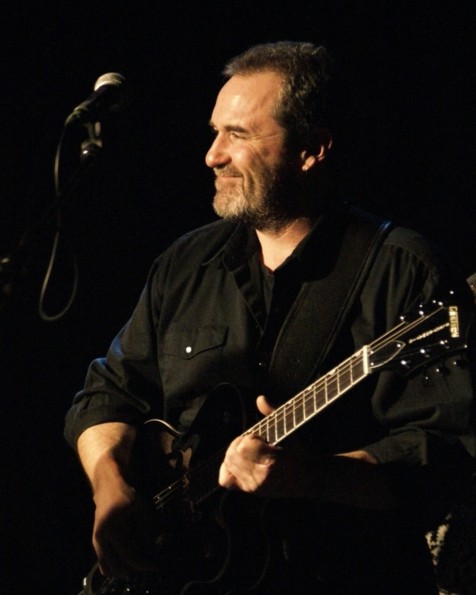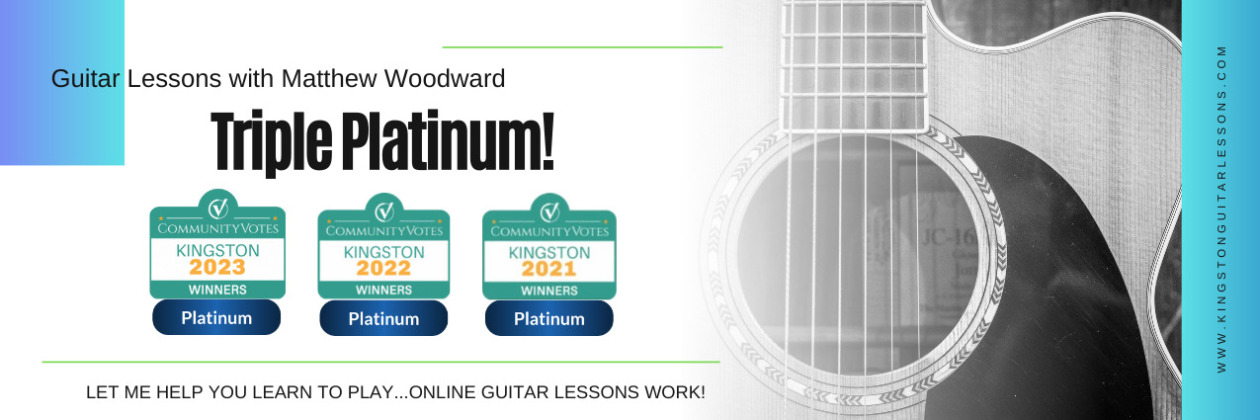Finding Your Voice
I had the good fortune of playing with a great Kingston alternative rock band called Gaudi Birds during 1995-6. One (okay, several) of our tunes would become long jams on a groove, as our lead singer, Justin Bird, would go into these really cool stream-of-consciousness lyrical improvisations.
I recall how one song often veered off into a simple E–D–A (I–flat 7–IV) mixolydian chord progression, reminiscent of “Gloria” by Van Morrison. For most of the jam, I would just comp on the cowboy chords in the first position. When I sensed that we were approaching the return to our own song I’d break into a descending figure using small 3-note voicings of the three chords, signalling my bandmates that the change was coming.
How I did that is what this post is about. You might, however, need a little preamble to help you understand.
The way in which the notes of a chord are arranged is referred to as the voicing of that chord. Think of your six strings as a little family choir group – daddy sings bass on the big 6th string, little sister sings the high notes on the 1st string. Each of the other four family members fit their own voice ranges in between on the other strings. Some chords we play have all six voices of the choir “singing”. Others may use only three or four while the others remain silent. You are the conductor, deciding who sings what note and when.
When changing from one chord to another we try to do so in such a way that none of the voices within the current chord has to move in an awkward way to get to the note it has to sing in the next chord. Some voices may move up while others move down. We try to avoid large leaps between notes. This careful consideration of how the voices will move is referred to as good voice leading.
Triads, such as the Major Chord have only three different notes to deal with. The standard names employed for close voicings of triads (in which all of the notes of the chord are within the span of one octave) are fairly easy to understand, even if you can’t yet read music:
Shown above are the C Major Scale and the close voicings that are possible for the C Major Triad, which combines the 1st (Root), 3rd, and 5th of the C Major Scale.
If the three notes of the triad are stacked as a chord with the Root as the lowest note, the 5th as the highest and the 3rd between those two, the triad is said to be in Root Position.
To invert something means to put it upside down or in the opposite position, order, or arrangement. If the lowest note of the Root Position triad is replaced with its octave so that the Root is now the highest note of the chord (while the 3rd and 5th remain the same), we have inverted its position relative to the rest of the chord. Hence, the triad that results is said to be in First Inversion.
Inverting the 3rd to its octave, so the triad is in the order of 5th, Root, 3rd, results in what is called the Second Inversion of the triad.
Finally, inverting the 5th to its octave results in an arrangement of Root, 3rd, 5th – a return to Root Position, but with all of the notes now an octave above where we started. From this point, the other inversions will similarly repeat themselves in the same order.
Remember that each of these three arrangements, Root Position, 1st Inversion and 2nd Inversion, are the same chord. Each can be called a C Major chord on its own. These terms are used simply to describe how the notes are stacked in a particular chord voicing.
Now you’ll better understand what I did. Mind you, this is all relatively basic stuff, using root position (1-3-5), 1st inversion (3-5-1) and 2nd inversion (5-1-3) close triad voicings of E, D and A, but it’s a good exercise and also fun to see the many ways one can play the same three chords. If you can’t read, just use the tab shown below each staff.
Since the E and D chords are only a tone away from each other, I played each of them using the same voicing for each measure. Notice how in the first bar both E and D are in root position voicings, while the A is in 1st inversion. Bar two has E and D in 2nd inversion, and the A in root position. Note that I’ve also written this out with each E chord being played twice so the progression will resemble “Gloria”.



Guitar players use a lot of big, 6-string chords when playing rhythm, but we really only need the three notes of the triad to form the chord. Voicing the chords in this fashion requires that you think more like a keyboard player. It keeps the chord progression moving and interesting. In my experience I have observed how the better players tend to use smaller chords to get their point across.
Play the exercise and see if you are able to understand the order in which the inversions switch up as the progression descends. Enjoy!
Let that be a lesson to you. 😉
If you enjoyed this post, please share it with others. I won’t mind.
















 gether.
gether. d knowing how to deal with them in a way that the audience (hopefully) won’t notice. As a performer, you will encounter many things beyond your control such as broken strings, equipment breakdowns,
d knowing how to deal with them in a way that the audience (hopefully) won’t notice. As a performer, you will encounter many things beyond your control such as broken strings, equipment breakdowns, For most audiences the vocal performance is the single most important feature of any song. Your chosen stage volume should never be such that it will drown out the singer(s). One of the best compliments a musician can give to another musician is to say that he or she “has big ears”, meaning that they listen to all of what’s being played and react to the others in the group. If you can’t hear the other members of your group, you’re too loud.
For most audiences the vocal performance is the single most important feature of any song. Your chosen stage volume should never be such that it will drown out the singer(s). One of the best compliments a musician can give to another musician is to say that he or she “has big ears”, meaning that they listen to all of what’s being played and react to the others in the group. If you can’t hear the other members of your group, you’re too loud. can be quite elaborate, involving key changes or modulations, but can also be as simple as having your drummer immediately kick into the beat of your next song. Keep your show moving along.
can be quite elaborate, involving key changes or modulations, but can also be as simple as having your drummer immediately kick into the beat of your next song. Keep your show moving along. Follow spotlights are wonderful tools in this respect and can be used to help guide your audience to look exactly at what you want them to.
Follow spotlights are wonderful tools in this respect and can be used to help guide your audience to look exactly at what you want them to.









































